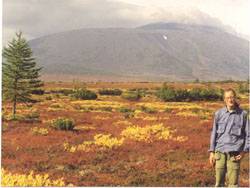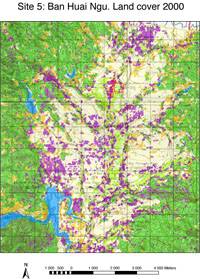Behaviour and Ecology
@ School of Life Sciences, University of Nottingham
| Home | People | Research | Teaching | Publications | Opportunities | Links |
Spatial processes in communities
Patterns and dynamics
of
boreal forests - Markus Eichhorn
 Markus
Eichhorn studies the
processes that determine the structure and composition of forests. This
includes work on scales from individual trees through to whole regions.
Individual trees form patterns within forests that vary between the
species
involved, in different locations and through time. Permanent plots
established
in the Bystrya Valley of Kamchatka in 1998 are providing data on the
structure
and dynamics of forests in this region.
Markus
Eichhorn studies the
processes that determine the structure and composition of forests. This
includes work on scales from individual trees through to whole regions.
Individual trees form patterns within forests that vary between the
species
involved, in different locations and through time. Permanent plots
established
in the Bystrya Valley of Kamchatka in 1998 are providing data on the
structure
and dynamics of forests in this region.
Right: Fieldwork in Kamchatka, Far East
On a larger scale, the next step is to
understand how regional
processes determine the composition of local communities of trees, and
the
various herbs and shrubs that grow beneath them. An analysis of forest
communities
across
 Competition, coexistence and the maintenance
of diversity - Tom Reader
Competition, coexistence and the maintenance
of diversity - Tom Reader
The principal of competitive exclusion (Hardin, 1960) predicts that two species competing for a single limiting resource cannot coexist indefinitely. So the diverse communities of invertebrates that we find exploiting some kinds of resource present us with a problem: how is diversity maintained in the face of intense interspecific competition? Tom Reader is interested in exploring answers to this question in a number of systems, and particularly in the effects of spatial aggregation, resource heterogeneity and predation on diversity.
Above right: Eggs of Lipara lucens (white) and L. rufitarsis (black) are laid on reed stems; intense competition for food means that only one can survive per stem.
The flies in the genus Lipara feed on common reed (Phragmites australis). Several species compete strongly for the same reed stems in wetlands throughout eastern England. Modelling work done in collaboration with Pej Rohani and Stephen Cornell shows that three mechanisms help maintain diversity in this little community: intraspecific aggregation of eggs, resource partitioning at the larval stage, and kleptoparasitism of the superior competitors by the weaker species. Find out more in the following references:
Reader T, Cornell SJ, Rohani P, (2006). Aggregation, intraguild interactions and the coexistence of competitors on small ephemeral patches. Oikos, 115: 321-333. PDF This is a preprint of an Article accepted for publication in Oikos © 2006 Blackwell Publishing.
Reader T, (2003). Strong interactions between species of phytophagous fly: a case of intraguild kleptoparasitism. Oikos 103:101-112. PDF This is an electronic version of an Article published in Oikos.
Transmission of malaria
and
dengue in Thailand - Markus Eichhorn
 Malaria and dengue fever are mosquito-borne
diseases with immense
public health implications for the countries that harbour them. The
RISKMODEL
project (Predicting the RISKs of MOsquito-borne DisEases from Land use
change)
is an attempt to provide an integrated model to describe the
transmission and
epidemiology of these diseases in northern
Malaria and dengue fever are mosquito-borne
diseases with immense
public health implications for the countries that harbour them. The
RISKMODEL
project (Predicting the RISKs of MOsquito-borne DisEases from Land use
change)
is an attempt to provide an integrated model to describe the
transmission and
epidemiology of these diseases in northern
As a member of the project, Markus Eichhorn is investigating the influence of local land-use, detected using remote-sensing techniques, on the abundance and community composition of mosquito vectors collected in ground surveys. Of particular interest are the effects of forests, which are diminishing in extent and becoming increasingly fragmented within the region, and orchards, which are replacing subsistence agriculture as the dominant agricultural practice in many villages.
More information about the broad aims and scope
of the project can be found here.
RISKMODEL is funded by the EU under the Quality of Life and Management
of
Living Resources Programme.
Vanwambeke
S.O., Lambin E.F., Eichhorn
M.P., Flasse S. P., Harbach R.E., Oskam L., Somboon P., van Beers S.,
van
Benthem B.H.B., Walton C. and Butlin R.K. (2007). Impact of land-use
change on
dengue and malaria in
